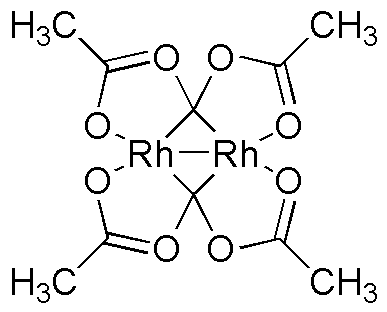Rhodium(II) acetate dimer dihydrate is widely utilized in research focused on:
- Catalysis: This compound serves as an effective catalyst in various organic reactions, particularly in the synthesis of complex molecules, making it invaluable in pharmaceutical development.
- Cross-Coupling Reactions: It plays a crucial role in cross-coupling reactions, such as Suzuki and Stille reactions, which are essential for forming carbon-carbon bonds in organic synthesis.
- Electrochemistry: Researchers use it in electrochemical applications, including sensors and energy storage devices, due to its ability to facilitate electron transfer processes.
- Material Science: The compound is employed in the development of advanced materials, including catalysts for fuel cells, enhancing efficiency and performance in energy applications.
- Environmental Chemistry: It is also explored for its potential in environmental remediation processes, helping to break down pollutants and improve sustainability in chemical manufacturing.
General Information
Properties
Safety and Regulations
Applications
Rhodium(II) acetate dimer dihydrate is widely utilized in research focused on:
- Catalysis: This compound serves as an effective catalyst in various organic reactions, particularly in the synthesis of complex molecules, making it invaluable in pharmaceutical development.
- Cross-Coupling Reactions: It plays a crucial role in cross-coupling reactions, such as Suzuki and Stille reactions, which are essential for forming carbon-carbon bonds in organic synthesis.
- Electrochemistry: Researchers use it in electrochemical applications, including sensors and energy storage devices, due to its ability to facilitate electron transfer processes.
- Material Science: The compound is employed in the development of advanced materials, including catalysts for fuel cells, enhancing efficiency and performance in energy applications.
- Environmental Chemistry: It is also explored for its potential in environmental remediation processes, helping to break down pollutants and improve sustainability in chemical manufacturing.
Documents
Safety Data Sheets (SDS)
The SDS provides comprehensive safety information on handling, storage, and disposal of the product.
Product Specification (PS)
The PS provides a comprehensive breakdown of the product’s properties, including chemical composition, physical state, purity, and storage requirements. It also details acceptable quality ranges and the product's intended applications.
Certificates of Analysis (COA)
Search for Certificates of Analysis (COA) by entering the products Lot Number. Lot and Batch Numbers can be found on a product’s label following the words ‘Lot’ or ‘Batch’.
*Catalog Number
*Lot Number
Certificates Of Origin (COO)
This COO confirms the country where the product was manufactured, and also details the materials and components used in it and whether it is derived from natural, synthetic, or other specific sources. This certificate may be required for customs, trade, and regulatory compliance.
*Catalog Number
*Lot Number
Safety Data Sheets (SDS)
The SDS provides comprehensive safety information on handling, storage, and disposal of the product.
DownloadProduct Specification (PS)
The PS provides a comprehensive breakdown of the product’s properties, including chemical composition, physical state, purity, and storage requirements. It also details acceptable quality ranges and the product's intended applications.
DownloadCertificates of Analysis (COA)
Search for Certificates of Analysis (COA) by entering the products Lot Number. Lot and Batch Numbers can be found on a product’s label following the words ‘Lot’ or ‘Batch’.
*Catalog Number
*Lot Number
Certificates Of Origin (COO)
This COO confirms the country where the product was manufactured, and also details the materials and components used in it and whether it is derived from natural, synthetic, or other specific sources. This certificate may be required for customs, trade, and regulatory compliance.


